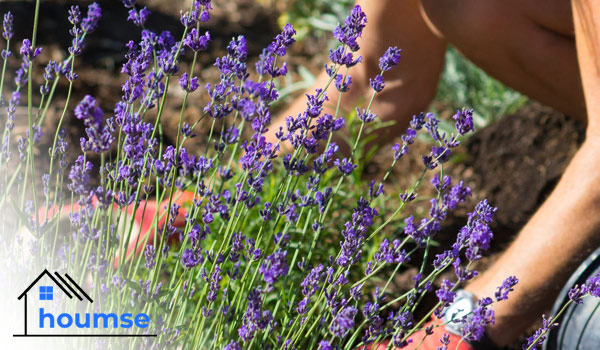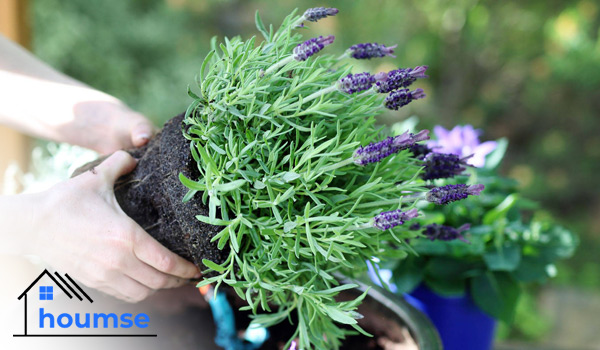Lavender Care: Growing Lavender in Pots & Outdoors

Aromatic, colorful, and easy to care for; this is the lavender flower, one of the most popular plants, both for its durability and for the incredible aroma that spreads in the house or garden.
By growing lavender, we can also take advantage of its flowers in different ways such as making homemade cosmetics, candles, air fresheners, cookies, etc.
Scroll through to find everything out about lavender care and how to keep it beautiful and radiant throughout the season.
Lavender Flower: A Quick Intro
With a pleasant and unmistakable aroma and an upright and rustic appearance, the lavender flower is one of the most charming, useful seasonal plants. It is native to the Mediterranean mountains and, from there, it spread to Australia and North America, through rocky and mountainous areas.
Although violet and purple are the most common colors of its flowers, there are also varieties of white, pink, and blue flowers. Its name comes from the Latin root ‘lavare’ meaning to wash. Interestingly, the first to use the lavender flower in daily life were the ancient Egyptians, as its oil was used in the mummification process.
Lavender in any of its varieties (there are more than 60 types) is perennial, so its leaves will not be renewed annually. Reaching up to 5 feet in height, this plant is a wild shrub that will take on a wooden appearance when not grown in pots and pruned.
This makes growing lavender ideal for creating beautiful borders, which will be even more striking when its unique blooms appear. With many different species, it allows you to choose the type you desire for any space.

Lavender Care in 5 Simple Steps
Lavender care is not too complicated. Being a wild shrub, this rustic plant does not require much from us to flower in the summer. This plant is even capable of growing in rocky areas and in full sun, which gives us a clue about growing lavender.
Let us find out what they are to enjoy this wonderful plant at home following these five simple steps:
1. What Type of Soil Does Lavender Need?
Lavender needs alkaline soil (that is, a potting media with a high pH) for proper growth. If the soil is acidic, you will have to compensate for that acidity with a specific soil, which you will need to apply on a recurring basis or even by adding lime to raise the pH.
When it comes to potting soil in lavender plant care, good drainage is also essential. For this, it is ideal to provide sandy soil (which facilitates water drainage with a minimum trace of moisture).
This aspect is especially important since lavender flower roots do not tolerate waterlogging in any season, especially in winter when excess water can make the root system freeze and kill the plant).
2. Where and When to Plant Lavender?
For successful lavender care, there is no specific place as long as it meets the necessary conditions, whether it is a suitable pot (which normally has a diameter between 12 to 15 inches) or in the garden.
What is important for growing lavender is that it has good aeration. So, avoid planting it very close to other plants while anticipating the dimension when it is mature. This way, the plant will thrive without hindering the growth of its neighbors.
And when to plant lavender? April or May when the soil is warm is the best time. Never plant this species in winter because (as mentioned earlier) young plants are vulnerable to rotting in cold, wet soils.
Does Lavender Need Full Sun?
In addition to choosing the right spot for growing lavender, it is essential that it receives direct sun for at least 6 hours a day. If planting in the garden, make sure no trees can rob it of the required light.
3. How to Water in Lavender Plant Care?
Given its rustic character, the lavender flower can withstand periods with no water in nature. However, you need to pay attention to the irrigation pattern in lavender care, especially in its growing months when you need water more. When watering, never wet the branches and flowers to prevent the risk of fungi.
During cold months, reduce the watering to every two weeks and move the irrigation sessions to the middle of the day so the soil is not still moist at night.
In warm months, water once a week but make sure that the 2 top inches of the soil are dried out. If it still retains moisture, wait a little longer before watering again.
4. Is Fertilizing Necessary for Growing Lavender?
Well, no. Actually, including fertilizer in lavender care may even discourage it. As a rustic bush, the lavender flower is not too demanding regarding soil quality. So, excessive feeding can cause its flowering to lose its characteristic aroma.
However, if the soil is poor and you are growing lavender in a pot, it is advisable to apply a minimum dilution of fertilizer before the flowering season.
5. Does Lavender Spread? When to Prune It?
Fertilizing may not be very important in lavender plant care, but pruning is. Why? Because once planted, the hedges can grow up to 2 feet tall while each plant can spread up to 5 feet.
Tip: Do not confuse pruning with picking the plant’s flowers for decorative or medicinal purposes.
At the beginning of spring or the arrival of autumn (always before or after the flowering season), it is best to carry out a small pruning that never exceeds half the size of the plant. Such pruning stimulates the growth of new branches as well as lavender flowers.
Do the same for those lavenders in borders hedges in the garden with a small difference: in addition to pruning in height, you can also prune its width and give it any shape you want.

Final Thoughts
And with these five steps on how to grow lavender, you can surely count on its wonderful fragrance during the summer months at home.
You can also consider growing several types outdoors, mixing and matching the intensity of tones and shape of lavender flowers to create the most striking flower beds and collections.
Do you have any other questions about how to care for lavender plant? Let us know in the comments and we will answer.
- In this post:
- Lavender Flower: A Quick Intro
- Lavender Care in 5 Simple Steps
- Final Thoughts



